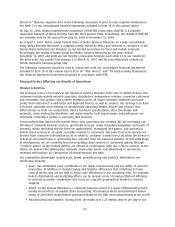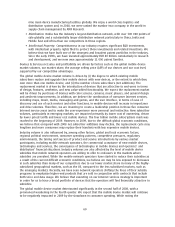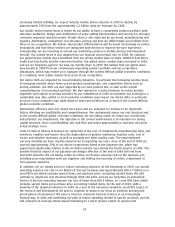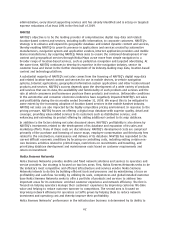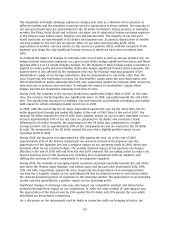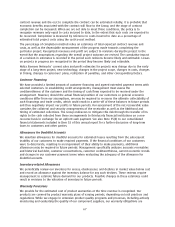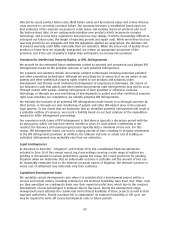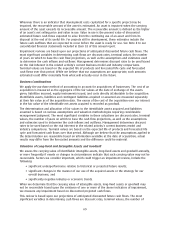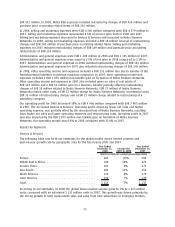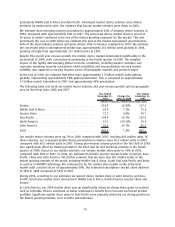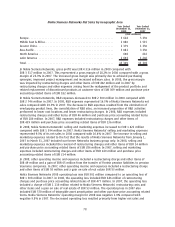Nokia 2008 Annual Report Download - page 69
Download and view the complete annual report
Please find page 69 of the 2008 Nokia annual report below. You can navigate through the pages in the report by either clicking on the pages listed below, or by using the keyword search tool below to find specific information within the annual report.affected by actual product failure rates (field failure rates) and by material usage and service delivery
costs incurred in correcting a product failure. Our warranty provision is established based upon our
best estimates of the amounts necessary to settle future and existing claims on products sold as of
the balance sheet date. As we continuously introduce new products which incorporate complex
technology, and as local laws, regulations and practices may change, it will be increasingly difficult to
anticipate our failure rates, the length of warranty periods and repair costs. While we believe that our
warranty provisions are adequate and that the judgments applied are appropriate, the ultimate cost
of product warranty could differ materially from our estimates. When the actual cost of quality of our
products is lower than we originally anticipated, we release an appropriate proportion of the
provision, and if the cost of quality is higher than anticipated, we increase the provision.
Provision for Intellectual Property Rights, or IPR, Infringements
We provide for the estimated future settlements related to asserted and unasserted past alleged IPR
infringements based on the probable outcome of each potential infringement.
Our products and solutions include increasingly complex technologies involving numerous patented
and other proprietary technologies. Although we proactively try to ensure that we are aware of any
patents and other intellectual property rights related to our products and solutions under
development and thereby avoid inadvertent infringement of proprietary technologies, the nature of
our business is such that patent and other intellectual property right infringements may and do occur.
Through contact with parties claiming infringement of their patented or otherwise exclusive
technology, or through our own monitoring of developments in patent and other intellectual property
right cases involving our competitors, we identify potential IPR infringements.
We estimate the outcome of all potential IPR infringements made known to us through assertion by
third parties, or through our own monitoring of patent and other IPRrelated cases in the relevant
legal systems. To the extent that we determine that an identified potential infringement will result in
a probable outflow of resources, we record a liability based on our best estimate of the expenditure
required to settle infringement proceedings.
Our experience with claims of IPR infringement is that there is typically a discussion period with the
accusing party, which can last from several months to years. In cases where a settlement is not
reached, the discovery and ensuing legal process typically lasts a minimum of one year. For this
reason, IPR infringement claims can last for varying periods of time, resulting in irregular movements
in the IPR infringement provision. In addition, the ultimate outcome or actual cost of settling an
individual infringement may materially vary from our estimates.
Legal Contingencies
As discussed in Item 8A7. “Litigation” and in Note 29 to the consolidated financial statements
included in Item 18 of this annual report, legal proceedings covering a wide range of matters are
pending or threatened in various jurisdictions against the Group. We record provisions for pending
litigation when we determine that an unfavorable outcome is probable and the amount of loss can
be reasonably estimated. Due to the inherent uncertain nature of litigation, the ultimate outcome or
actual cost of settlement may materially vary from estimates.
Capitalized Development Costs
We capitalize certain development costs when it is probable that a development project will be a
success and certain criteria, including commercial and technical feasibility, have been met. These costs
are then amortized on a systematic basis over their expected useful lives, which due to the constant
development of new technologies is between two to five years. During the development stage,
management must estimate the commercial and technical feasibility of these projects as well as their
expected useful lives. Should a product fail to substantiate its estimated feasibility or life cycle, we
may be required to write off excess development costs in future periods.
68



